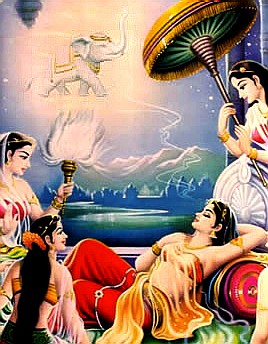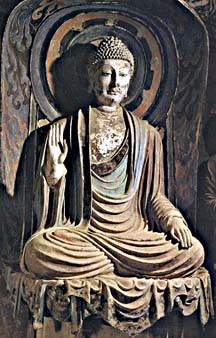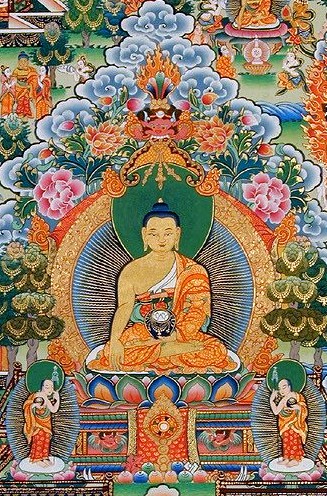|
Buddha Around 560 B.C., according to legend, a woman dreamt "that a white elephant carrying a white lotus in its trunk came and entered her womb through her right flank."
Around 560 B.C., according to legend, a woman dreamt "that a white elephant carrying a white lotus in its trunk came and entered her womb through her right flank."
This was interpreted as a good omen, rather than the grisly and painful ordeal it sounds like. Nine months after this wild night of passion, the woman gave birth to Siddhartha, the boy who would grow up to be Buddha. (Understandably, the lotus flower has outpaced the rapist elephant as the more widely disseminated symbol of Buddhism.) Siddhartha's father was a king, and he grew up in luxury. He married and had a son, but the fat and happy life wasn't for him. Discontented, he strayed from his home to see how the little people lived. Siddhartha encountered four people during these excursions. Had he encountered a clown, a juggler, a puppy and a sweet young thing, it would have changed the course of Eastern civilization. But young Siddhartha's roaming led him to a series of downers. The sight of an old man taught him the inevitability of decay. The sight of a sick man taught him the inevitability of suffering. The sight of a corpse taught him the inevitability of death. The sight of a monk taught him that serenity was the best one could hope for in life.
Realizing he was heading toward a joyless life and an early death, Siddhartha decided this approach wasn't working out either. Exasperated, he parked himself under a tree, vowing not to leave the spot until he had achieved enlightenment. According to Buddhist scriptures, "he neither bathed, nor rinsed his mouth, nor did he ease himself; but was wholly taken up by the delights of the Trances, of the Paths, and of the Fruits." Despite temptations from evil spirits and a series of supernatural distractions, Siddhartha emerged from his ordeal smelly and enlightened, and assumed the title of Buddha, which means "enlightened one." The deities of 10,000 worlds commended him for his accomplishment, but he didn't let it go to his head. Buddha recited the formal Buddha's creed, articulating the basic premise that would go on to inspire billions:
Through birth and rebirth's endless round,The concept outlined here, more or less, is that human existence consists of an extremely long cycle of birth, death and reincarnation in which the traveling soul continually refines itself in search of divine wisdom. By demolishing his ego, the attachment to self and mind, Buddha freed himself from earthly desires and attachment to material things. Buddha had reached Nirvana without the pain of sleeping with Courtney Love -- a blissful liberation from the cycle of reincarnation through direct communion with the divine. Now officially the founder of a religion, Buddha did what anyone would do. He went looking for disciples. He started with his former colleagues in asceticism, who were relieved to discover they could start eating again. The platform he outlined was based around "four noble truths" and an "eightfold path."
Newly enlightened, Buddha took his message to the streets. Unlike Jesus, he opted out of an early and painful death in favor of a long life peacefully propagating his beliefs. While Jesus benefitted from the quick surge in popularity which comes from a spectacular death, Buddha had the advantage of 50 extra years personally teaching people his beliefs, a big plus in terms of making sure his followers were getting it right and perhaps one reason why you don't read too much about Buddhist Crusades and Inquisitions. For the remainder of his life, Siddhartha Buddha traveled the plains of India and Pakistan, winning followers and setting up his religion. Despite an assassination attempt employing the time-honored tool of political enmity -- a wild elephant -- Buddha lived to the ripe old age of 80, and died in his bed. As the deities of 10,000 worlds wept, Buddha relinquished his spirit, continuing to issue precepts of enlightenment the whole time. His final words to his disciples summed it up: "And now, O priests, I take my leave of you; all the elements of being are transitory. Work out your salvation with diligence." Passing through four trances, Siddhartha Buddha is said to have entered Nirvana.
The Many Faces Of Buddha But that's not quite the end of the story. As Buddhism developed over the years, a set of tales laid out the afterlife -- prelife -- of the Enlightened One. Depending on your flavor of Buddhism, and there are several, you might believe that Buddha has had up to seven incarnations on this earth, and you probably believe he'll be back for the big finale.
But that's not quite the end of the story. As Buddhism developed over the years, a set of tales laid out the afterlife -- prelife -- of the Enlightened One. Depending on your flavor of Buddhism, and there are several, you might believe that Buddha has had up to seven incarnations on this earth, and you probably believe he'll be back for the big finale. Aside from Siddhartha, there are a few incarnations of Buddha that get talked about on a fairly regular basis. They include:
Buddha Says..."He who loves 50 people has 50 woes; he who loves no one has no woes." |
 Siddhartha took up the practice of yoga in order to begin purifying his soul. But he found that yoga alone wasn't enough to reach enlightenment, not even bikram yoga or yogaerobics. Upping the ante, he fasted and denied himself all the pleasures of life for several years.
Siddhartha took up the practice of yoga in order to begin purifying his soul. But he found that yoga alone wasn't enough to reach enlightenment, not even bikram yoga or yogaerobics. Upping the ante, he fasted and denied himself all the pleasures of life for several years.  The truths were:
The truths were: